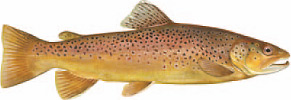 Scientific Name
Scientific Name
Salmo trutta
Other Common Names
English brown trout, German brown trout, European trout
Identification
Colors vary widely. Natural wild browns are olivebrown on the back, lighter on the sides, brilliant yellow-gold on their underside, with yellowish-green, unspotted fins. They have numerous black or dark brown spots on their sides, along with a sprinkling of red spots encircled with light blue rings. Hatchery-reared browns tend to be more silvery with dark brownish above with light yellow undersides and spots of a lighter shade.
Best Fishing
Lakes: Moomaw. Rivers and Streams: Little River, Mossy Creek, Potts Creek, Back Creek, Jackson River, Smith River and a wide array of others on either side of the Blue Ridge and in Southwestern Virginia.
Fishing Techniques
Will rise to dry flies as well as hitting wet flies, streamers and nymphs. Worms, live nymphs, minnows and salmon eggs are good too. Brown trout tend to be bigger “meat eaters” in that they’ll take larger live baits more readily and will hit spinners, spinner bucktail combinations, as well as small crankbaits and spoons. Live baits and wet flies are normally fished downstream while dry flies are fished upstream.
Fishing for Fall Brown Trout in Virginia
Feeding Habits
Aquatic and terrestrial insects, mollusks, small fish, crayfish, salamanders, frogs, even small mammals or birds. Fish and crayfish are the main diet of larger browns.
Habitat
Usually in larger waters with plenty of rock structure, submerged logs and overhanging banks.
Spawning Habits
They spawn naturally in fall. Females fan out up to four different nests. They spawn in tributary stream or shallow shoal waters.

